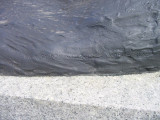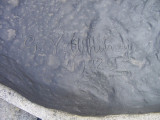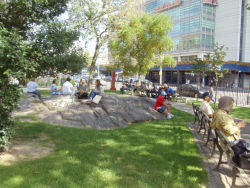Mitchel Square
View all monuments in NYC Parks, as well as temporary public art installations on our NYC Public Art Map and Guide.
Washington Heights-Inwood War Memorial
| Artist: | Gertrude Vanderbilt Whitney |
| Dedicated: | May 30, 1923 |
| Location: | Broadway and St. Nicholas Avenue, between 167th and 168th Streets |
Artwork History
This impressive monument stands at the apex of Mitchel Square, where Broadway and St. Nicholas Avenue converge at West 168 Street. The memorial’s central image, by the esteemed sculptor and art patron Gertrude Vanderbilt Whitney (1875–1942), is a three figure group in bronze depicting two soldiers, one kneeling and one standing, who support a third slumping comrade in battle. The monument, which was dedicated on May 30, 1922, honors those men from the adjacent communities in northern Manhattan of Washington Heights and Inwood who gave their lives while serving their country in World War I.
Gertrude Vanderbilt Whitney was born in New York City on January 9, 1875. In her youth she trained with private tutors, at the Brearley School, and with Hendrik C. Anderson and James Earle Fraser at the Art Students League. Whitney was active in the war relief effort, and established a hospital for wounded soldiers in the Parisian suburb of Juilly. This experience caused her to model a series of 24 small bronzes based on battles scenes, which were exhibited in 1919 at the Whitney Studio in Greenwich Village in the show “Impressions of the War.” Her involvement in the war found sculptural expression in evocative large-scale memorials which she executed in the United States and France.
This monument was commissioned by the Washington Heights and Inwood Memorial Association. They retained the renowned architectural firm of Delano and Aldrich, who designed the circular granite pedestal, set within a two-colored flagstone paving into which are set 20 bronze star-shaped plaques listing the 357 local casualties. The architect Albert Randolph Ross also collaborated with Whitney on the DAR Memorial (1929) in Washington, DC.
The monument’s dedication on Memorial Day 1922 coincided with parades and military demonstrations throughout the five boroughs. Whitney, just back from an arduous six-week trip abroad, curtailed her vacation to participate in the festivities, which were witnessed by several thousand spectators lining the streets. For her work on this monument Whitney won an award from the New York Society of Architects.
One of Whitney’s last works was the Peter Stuyvesant statue, which she created for the Netherlands Pavilion of the New York World’s Fair of 1939, and which was later installed in 1941 in the western portion of Stuyvesant Square Park. Besides her prolific career as a sculptor, she established the Whitney Museum of American Art in 1930. She died in New York City on April 18, 1942.
The parkland is named for John Purroy Mitchel (1879–1918), a reform mayor, and also the youngest in New York City’s history, who was killed during a flight training accident in World War I. In 1998 the monument was fully restored, and a long-missing bayonet replicated, as part of an overall renovation to the park funded by Council Member Guillermo Linares.
Artwork Details
| Description: | Group of three doughboy figures (over life-size) with integral plinth on a low base that rests on a circular pedestal; twenty plaques facing upward and carrying the names of the dead surround the group |
| Architect: | Delano and Aldrich |
| Materials: | Bronze, Deer Isle granite |
| Dimensions: | H: 12'10" Diameter 12'; each memorial tablet, 14" x 17" |
| Donor: | Washington Heights & Inwood Memorial Association |
| Cast: | 1923 |
Inscription
ERECTED BY THE PEOPLE OF WASHINGTON HEIGHTS AND INWOOD IN COMMEMORATION OF THE MEN WHO GAVE THEIR LIVES IN THE WORLD WARPlease note, the NAME field includes a primary designation as well as alternate namingsoften in common or popular usage. The DEDICATED field refers to the most recent dedication, most often, butnot necessarily the original dedication date. If the monument did not have a formal dedication, the yearlisted reflects the date of installation.
For more information, please contact Art & Antiquities at (212) 360-8163.
Check out your park's Vital Signs
Clean & Safe
Green & Resilient
Empowered & Engaged Users
Share your feedback or learn more about how this park is part of a
Vital Park System































